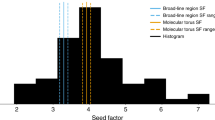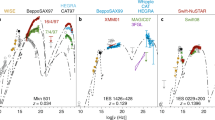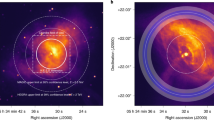Abstract
The nearby radio galaxy Centaurus A belongs to a class of active galaxies that are luminous at radio wavelengths. Most show collimated relativistic outflows known as jets, which extend over hundreds of thousands of parsecs for the most powerful sources. Accretion of matter onto the central supermassive black hole is believed to fuel these jets and power their emission1. Synchrotron radiation from relativistic electrons causes the radio emission, and it has been suggested that the X-ray emission from Centaurus A also originates in electron synchrotron processes2,3,4. Another possible explanation is inverse Compton scattering with cosmic microwave background (CMB) soft photons5,6,7. Synchrotron radiation needs ultrarelativistic electrons (about 50 teraelectronvolts) and, given their short cooling times, requires some continuous re-acceleration mechanism8. Inverse Compton scattering, on the other hand, does not require very energetic electrons, but the jets must stay highly relativistic on large scales (exceeding 1 megaparsec). Some recent evidence disfavours inverse Compton-CMB models9,10,11,12, although other work seems to be compatible with them13,14. In principle, the detection of extended γ-ray emission, which directly probes the presence of ultrarelativistic electrons, could distinguish between these options. At gigaelectronvolt energies there is also an unusual spectral hardening15,16 in Centaurus A that has not yet been explained. Here we report observations of Centaurus A at teraelectronvolt energies that resolve its large-scale jet. We interpret the data as evidence for the acceleration of ultrarelativistic electrons in the jet, and favour the synchrotron explanation for the X-rays. Given that this jet is not exceptional in terms of power, length or speed, it is possible that ultrarelativistic electrons are commonplace in the large-scale jets of radio-loud active galaxies.
This is a preview of subscription content, access via your institution
Access options
Access Nature and 54 other Nature Portfolio journals
Get Nature+, our best-value online-access subscription
$29.99 / 30 days
cancel any time
Subscribe to this journal
Receive 51 print issues and online access
$199.00 per year
only $3.90 per issue
Buy this article
- Purchase on Springer Link
- Instant access to full article PDF
Prices may be subject to local taxes which are calculated during checkout


Similar content being viewed by others
Data availability statement
The raw H.E.S.S. data and the code used in this study are not public, but belong to the H.E.S.S. collaboration. All derived higher-level data that are shown in the plots will be made available on the H.E.S.S. collaboration’s website on publication of this study.
Change history
24 June 2020
A Correction to this paper has been published: https://doi.org/10.1038/s41586-020-2455-x
References
Blandford, R., Meier, D. & Readhead, A. Relativistic jets from active galactic nuclei. Annu. Rev. Astron. Astrophys. 57, 467–509 (2019).
Feigelson, E. D. et al. The X-ray structure of Centaurus A. Astrophys. J. 251, 31–51 (1981).
Kraft, R. P. et al. Chandra observations of the X-ray jet in Centaurus A. Astrophys. J. 569, 54–71 (2002).
Snios, B. et al. Variability and proper motion of X-ray knots in the jet of Centaurus A. Astrophys. J. 871, 248 (2019).
Celotti, A., Ghisellini, G. & Chiaberge, M. Large-scale jets in active galactic nuclei: multiwavelength mapping. Mon. Not. R. Astron. Soc. 321, L1–L5 (2001).
Harris, D. E. & Krawczynski, H. X-ray emission from extragalactic jets. Annu. Rev. Astron. Astrophys. 44, 463–506 (2006).
Simionescu, A. et al. Serendipitous discovery of an extended X-ray jet without a radio counterpart in a high-redshift quasar. Astrophys. J. Lett. 816, L15 (2016).
Liu, R.-Y., Rieger, F. M. & Aharonian, F. A. Particle acceleration in mildly relativistic shearing flows: the interplay of systematic and stochastic effects, and the origin of the extended high-energy emission in AGN jets. Astrophys. J. 842, 39 (2017).
Georganopoulos, M., Meyer, E. & Perlman, E. Recent progress in understanding the large scale jets of powerful quasars. Galaxies 4, 65 (2016).
Breiding, P. et al. Fermi non-detections of four X-ray jet sources and implications for the IC/CMB mechanism. Astrophys. J. 849, 95 (2017).
Sun, X.-N., Yang, R.-Z., Rieger, F. M., Liu, R.-Y. & Aharonian, F. Energy distribution of relativistic electrons in the kiloparsec scale jet of M 87 with Chandra. Astron. Astrophys. 612, A106 (2018).
Marshall, H. L. et al. An X-ray imaging survey of quasar jets: the complete survey. Astrophys. J. 856, 66 (2018).
Lucchini, M., Tavecchio, F. & Ghisellini, G. Revisiting the EC/CMB model for extragalactic large scale jets. Mon. Not. R. Astron. Soc. 466, 4299–4306 (2017).
Meyer, E. T. et al. The origin of the X-ray emission in two well-aligned extragalactic jets: the case for IC/CMB. Astrophys. J. 883, L2 (2019).
Sahakyan, N., Yang, R., Aharonian, F. A. & Rieger, F. M. Evidence for a second component in the high-energy core emission from Centaurus A? Astrophys. J. Lett. 770, L6 (2013).
Abdalla, H. et al. The γ-ray spectrum of the core of Centaurus A as observed with H.E.S.S. and Fermi-LAT. Astron. Astrophys. 619, A71 (2018).
Harris, G. L. H., Rejkuba, M. & Harris, W. E. The distance to NGC 5128 (Centaurus A). Publ. Astron. Soc. Aust. 27, 457–462 (2010).
Burns, J. O., Feigelson, E. D. & Schreier, E. J. The inner radio structure of Centaurus A — clues to the origin of the jet X-ray emission. Astrophys. J. 273, 128–153 (1983).
Israel, F. P. Centaurus A – NGC 5128. Astron. Astrophys. Rev. 8, 237–278 (1998).
Kraft, R. P. et al. A Chandra high-resolution X-ray image of Centaurus A. Astrophys. J. Lett. 531, L9–L12 (2000).
Aab, A. et al. An indication of anisotropy in arrival directions of ultra-high-energy cosmic rays through comparison to the flux pattern of extragalactic gamma-ray sources. Astrophys. J. 853, L29 (2018).
Hartman, R. C. et al. The third EGRET catalog of high-energy gamma-ray sources. Astrophys. J. Suppl. Ser. 123, 79–202 (1999).
Aharonian, F. et al. Discovery of very high energy γ-ray emission from Centaurus A with H.E.S.S. Astrophys. J. Lett. 695, L40–L44 (2009).
Chiaberge, M., Capetti, A. & Celotti, A. The BL Lac heart of Centaurus A. Mon. Not. R. Astron. Soc. 324, L33–L37 (2001).
Lenain, J.-P., Boisson, C., Sol, H. & Katarzyński, K. A synchrotron self-Compton scenario for the very high energy γ-ray emission of the radiogalaxy M 87. Unifying the TeV emission of blazars and other AGNs? Astron. Astrophys. 478, 111–120 (2008).
Abdo, A. A. et al. Fermi gamma-ray imaging of a radio galaxy. Science 328, 725–729 (2010).
Aharonian, F. A. et al. Observations of the Crab nebula with HESS. Astron. Astrophys. 457, 899–915 (2006).
Holler, M., Chevalier, J., Lenain, J. P., Sanchez, D. & de Naurois, M. Run-wise simulations for imaging atmospheric Cherenkov telescope arrays. In Proc. 35th Int. Cosmic Ray Conf. 755 (Proceedings of Science, 2017).
Freeman, P., Doe, S. & Siemiginowska, A. Astronomical data analysis. Proc. SPIE 4477, 76–87 (2001).
Hardcastle, M. J. et al. Radio and X-ray observations of the jet in Centaurus A. Astrophys. J. 593, 169–183 (2003).
Gillesen, S. Sub-Bogenminuten-genaue Positionen von TeV-Quellen mit H.E.S.S. PhD thesis, Ruprecht-Karls-Univ. Heidelberg (2004).
Ma, C. et al. The international celestial reference frame as realized by very long baseline interferometry. Astron. J. 116, 516–546 (1998).
Hardcastle, M. J. & Croston, J. H. Modelling TeV γ-ray emission from the kiloparsec-scale jets of Centaurus A and M87. Mon. Not. R. Astron. Soc. 415, 133–142 (2011).
Bednarek, W. GeV-TeV γ-rays produced by electrons in the kpc-scale jet as a result of Comptonization of the inner jet emission. Mon. Not. R. Astron. Soc. 483, 1003–1007 (2019).
Tanada, K., Kataoka, J. & Inoue, Y. Inverse Compton scattering of starlight in the kiloparsec-scale jet in Centaurus A: the origin of excess TeV γ-ray emission. Astrophys. J. 878, 139 (2019).
Hardcastle, M. J., Kraft, R. P. & Worrall, D. M. The infrared jet in Centaurus A: multiwavelength constraints on emission mechanisms and particle acceleration. Mon. Not. R. Astron. Soc. Lett. 368, L15–L19 (2006).
The CTA Consortium. Science with the Cherenkov Telescope Array (World Scientific, 2019).
Tavecchio, F. Gamma rays from blazars. Am. Inst. Phys. Conf. Ser. 1792, 020007 (2017).
Condon, J. J., Helou, G., Sanders, D. B. & Soifer, B. T. A 1.425 GHz atlas of the IRAS bright galaxy sample, part II. Astrophys. J. Suppl. Ser. 103, 81–108 (1996).
Hahn, J. et al. Impact of aerosols and adverse atmospheric conditions on the data quality for spectral analysis of the H.E.S.S. telescopes. Astropart. Phys. 54, 25–32 (2014).
de Naurois, M. & Rolland, L. A high performance likelihood reconstruction of γ-rays for imaging atmospheric Cherenkov telescopes. Astropart. Phys. 32, 231–252 (2009).
Berge, D., Funk, S. & Hinton, J. Background modelling in very-high-energy γ-ray astronomy. Astron. Astrophys. 466, 1219–1229 (2007).
Cash, W. Parameter estimation in astronomy through application of the likelihood ratio. Astrophys. J. 228, 939–947 (1979).
Storn, R. & Price, K. Differential evolution: a simple and efficient adaptive scheme for global optimization over continuous spaces. J. Glob. Optim. 11, 341–359 (1997).
Parsons, R. D. & Hinton, J. A. A Monte Carlo template based analysis for air-Cherenkov arrays. Astropart. Phys. 56, 26–34 (2014).
Hardcastle, M. J. et al. New results on particle acceleration in the Centaurus A jet and counterjet from a deep Chandra observation. Astrophys. J. Lett. 670, L81–L84 (2007).
Yang, R. Z., Sahakyan, N., de Ona Wilhelmi, E., Aharonian, F. & Rieger, F. Deep observation of the giant radio lobes of Centaurus A with the Fermi Large Area Telescope. Astron. Astrophys. 542, A19 (2012).
Sun, X.-n., Yang, R.-z., Mckinley, B. & Aharonian, F. Giant lobes of Centaurus A as seen in radio and γ-ray images obtained with the Fermi-LAT and Planck satellites. Astron. Astrophys. 595, A29 (2016).
Kataoka, J. et al. The X-ray jet in Centaurus A: clues to the jet structure and particle acceleration. Astrophys. J. 641, 158–168 (2006).
Struve, C., Oosterloo, T. A., Morganti, R. & Saripalli, L. Centaurus A: morphology and kinematics of the atomic hydrogen. Astron. Astrophys. 515, A67 (2010).
Israel, F. P., Güsten, R., Meijerink, R., Requena-Torres, M. A. & Stutzki, J. The outflow of gas from the Centaurus A circumnuclear disk. Atomic spectral line maps from Herschel/PACS and APEX. Astron. Astrophys. 599, A53 (2017).
Weiß, A. et al. LABOCA observations of nearby, active galaxies. Astron. Astrophys. 490, 77–86 (2008).
Wykes, S. et al. Mass entrainment and turbulence-driven acceleration of ultra-high energy cosmic rays in Centaurus A. Astron. Astrophys. 558, A19 (2013).
van den Bergh, S. The post-eruptive galaxy NGC 5128 = Centaurus A. Astrophys. J. 208, 673–682 (1976).
Stawarz, Ł. Aharonian, F., Wagner, S. & Ostrowski, M. Absorption of nuclear γ-rays on the starlight radiation in FR I sources: the case of Centaurus A. Mon. Not. R. Astron. Soc. 371, 1705–1716 (2006).
Aharonian, F. A. & Atoyan, A. M. Compton scattering of relativistic electrons in compact X-ray sources. Astrophys. Space Sci. 79, 321–336 (1981).
Zabalza, V. naima: a Python package for inference of relativistic particle energy distributions from observed nonthermal spectra. In Proc. of Int. Cosmic Ray Conf. 2015 922 (Proceedings of Science, 2015).
Aharonian, F. A., Kelner, S. R. & Prosekin, A. Y. Angular, spectral, and time distributions of highest energy protons and associated secondary gamma rays and neutrinos propagating through extragalactic magnetic and radiation fields. Phys. Rev. D 82, 043002 (2010).
Khangulyan, D., Aharonian, F. A. & Kelner, S. R. Simple analytical approximations for treatment of inverse Compton scattering of relativistic electrons in the blackbody radiation field. Astrophys. J. 783, 100 (2014).
Acknowledgements
The support of the Namibian authorities and of the University of Namibia in facilitating the construction and operation of H.E.S.S. is gratefully acknowledged, as is the support by the German Ministry for Education and Research (BMBF), the Max Planck Society, the German Research Foundation (DFG), the Helmholtz Association, the Alexander von Humboldt Foundation, the French Ministry of Higher Education, Research and Innovation, the Centre National de la Recherche Scientifique (CNRS/IN2P3 and CNRS/INSU), the Commissariat à l’énergie atomique et aux énergies alternatives (CEA), the UK Science and Technology Facilities Council (STFC), the Knut and Alice Wallenberg Foundation, the National Science Centre, Poland (grant no. 2016/22/M/ST9/00382), the South African Department of Science and Technology, the South African National Research Foundation, the University of Namibia, the National Commission on Research, Science and Technology of Namibia (NCRST), the Austrian Federal Ministry of Education, Science and Research and the Austrian Science Fund (FWF), the Australian Research Council (ARC), the Japan Society for the Promotion of Science and the University of Amsterdam. We appreciate the excellent work of the technical support staff in Berlin, Zeuthen, Heidelberg, Palaiseau, Paris, Saclay, Tübingen and Namibia in the construction and operation of the equipment. This work benefited from services provided by the H.E.S.S. Virtual Organisation, supported by the national resource providers of the EGI Federation.
Author information
Authors and Affiliations
Consortia
Contributions
M. Holler, M.d.N. and D.A.S. analysed and interpreted the H.E.S.S. data and prepared the manuscript. F.R. and A.M.T. performed the modelling and prepared the manuscript. The entire H.E.S.S. Collaboration contributed to the publication with involvement at various stages, from the design, construction and operation of the instrument to the development and maintenance of all software for data handling, data reduction and data analysis. All authors reviewed, discussed and commented on the present results and the manuscript.
Corresponding authors
Ethics declarations
Competing interests
The authors declare no competing interests.
Additional information
Peer review information Nature thanks Roopesh Ojha and the other, anonymous, reviewer(s) for their contribution to the peer review of this work.
Publisher’s note Springer Nature remains neutral with regard to jurisdictional claims in published maps and institutional affiliations.
Extended data figures and tables
Extended Data Fig. 1 One-dimensional projections of VHE events.
Shown are projections of the VHE γ-ray emission from Centaurus A along the alignment of the semi-major axis obtained from the two-dimensional elliptical morphology fit (left; negative values correspond to φ = 43.4° and positive ones to φ + 180°) and perpendicular to it (right; φ + 90° for negative and φ + 270° for positive distances). The dashed red line shows the projection of the PSF on both sides. The blue line on the left panel corresponds to the PSF-convolved best-fit Gaussian model. Error bars on the ordinate denote statistical uncertainties (±1 s.d.), those along the abscissa illustrate the bin size.
Extended Data Fig. 2 Relevant timescales in the jet.
Characteristic electron cooling timescales (ordinate) in the kiloparsec-scale jet of Centaurus A as a function of electron energy (abscissa; the corresponding electron Lorentz factor is also shown along the top of the graph). Achievable particle energies are essentially limited by synchrotron losses. The solid green line represents the timescale for electron acceleration, and the solid purple line the dynamical or advection timescale. The dashed and dotted lines represent the timescales on which electrons lose energy, that is, via synchrotron radiation (light blue line) or inverse Compton (IC) scattering off ambient photons (dust, yellow line; starlight, orange line; CMB, dark blue line).
Extended Data Fig. 3 γ-ray SED of Centaurus A.
Comparison of the resultant γ-ray SEDs for Centaurus A including an earlier energy cut-off γcmec2 for the electron distribution at γc ≈ 107 (dashed line), everything else being kept the same as for Fig. 2. An extension of the electron distribution to γ = 108 is needed to fully account for the observed VHE spectrum (solid line). Red points refer to Fermi-LAT observations (error bars), usually attributed to emission from the core which is not modelled here. The blue-shaded butterfly represents VHE observations by H.E.S.S.16.
Rights and permissions
About this article
Cite this article
The H.E.S.S. Collaboration. Resolving acceleration to very high energies along the jet of Centaurus A. Nature 582, 356–359 (2020). https://doi.org/10.1038/s41586-020-2354-1
Received:
Accepted:
Published:
Issue Date:
DOI: https://doi.org/10.1038/s41586-020-2354-1
This article is cited by
-
The nature of compact radio sources: the case of FR 0 radio galaxies
The Astronomy and Astrophysics Review (2023)
-
Event Horizon Telescope observations of the jet launching and collimation in Centaurus A
Nature Astronomy (2021)
Comments
By submitting a comment you agree to abide by our Terms and Community Guidelines. If you find something abusive or that does not comply with our terms or guidelines please flag it as inappropriate.



